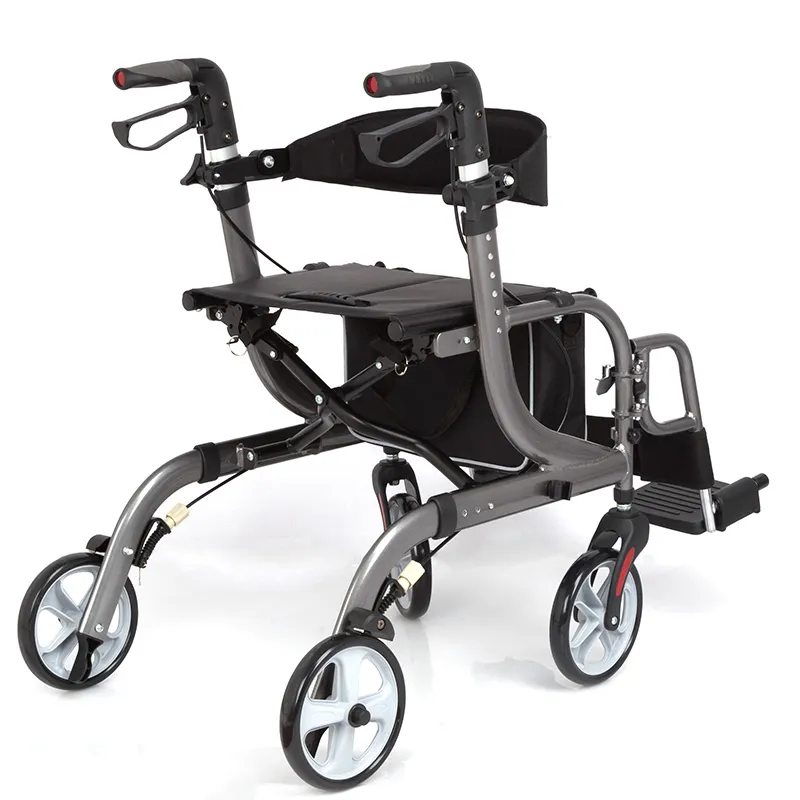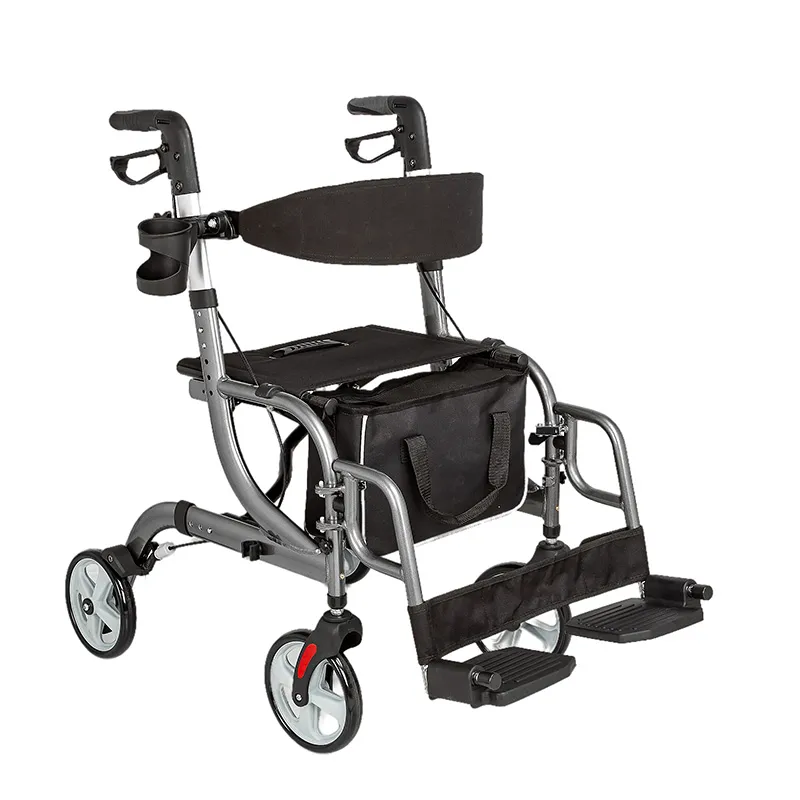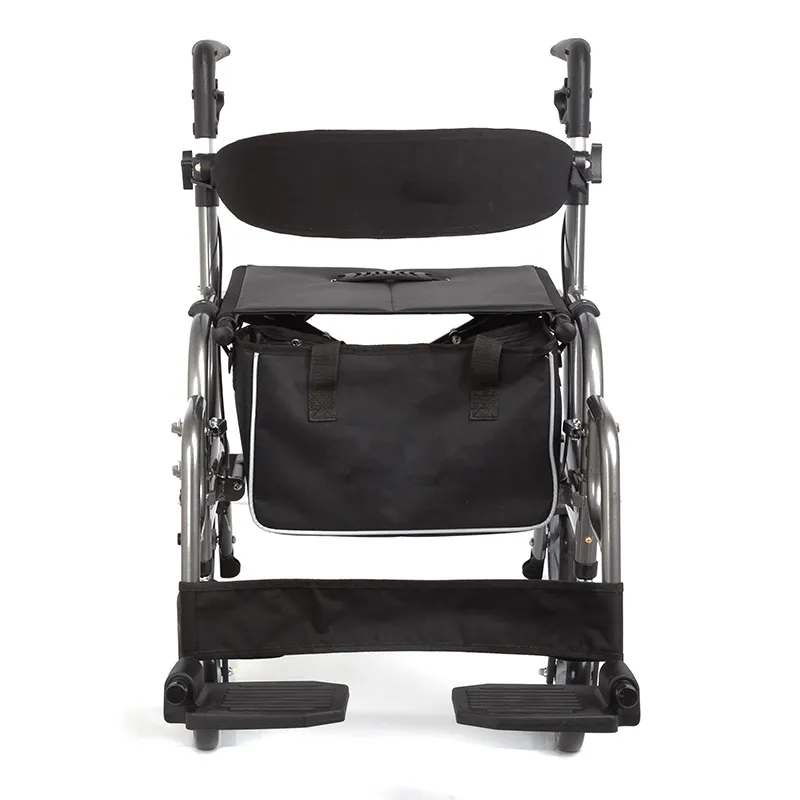
What are the side effects of using a rollator walker for a long time?
2024-08-21 15:30
As a common and effective walking aid, the rollator walker is widely welcomed by the elderly. However, while the rollator walker helps to enhance the mobility and safety of the elderly, the long-term use of this device may also bring some side effects.
This article will take a deep look at the various problems that may be caused by the long-term use of the rolling walker, and how to effectively prevent and manage these side effects.

Basic functions and advantages of the rollator walker
Before discussing the side effects, you first need to understand the basic functions and advantages of the rollator walker. The rollator walker usually includes the following main components:
● Four wheels: Provide good mobility and stability.
● Handbrake: Help users stop quickly when needed and increase safety.
● Seat: Users can rest at any time when they are tired.
● Storage basket: Easy to carry personal items.
These designs make the rollator walker very beneficial to the elderly in many ways, including improving walking stability, reducing joint burden, enhancing independence and providing a sense of security. However, the long-term use of the rollator walker may also lead to a series of side effects.

What are the side effects of using a rollator walker for a long time?
Side effects of long-term use of rollator walker:
● Increased Rollato dependence,
● Muscle atrophy (reduced frequency of use of core muscles),
● Poor posture (excessive bending, forward or sideways leaning),
● Increased joint burden (joint fatigue and pain),
● Psychological effects (anxiety, depression, etc.).
1. Increased rollator walker dependence:
● Cause analysis:
Long-term reliance on rollator walker for walking may cause the elderly to gradually lose trust and reliance on their own body functions, resulting in a decrease in the body's self-regulation ability. Excessive reliance on assistive devices will cause the elderly to ignore the importance of daily exercise and rehabilitation training, further weakening muscle strength and coordination.
● Preventive measures:
In order to avoid increased dependence, the elderly should maintain muscle strength and flexibility under the guidance of a doctor or physical therapist, combined with appropriate rehabilitation training and exercise plans. In addition, family members and caregivers should also encourage the elderly to engage in appropriate physical activities to reduce excessive reliance on rollator walkers.
2. Muscle atrophy:
● Cause analysis:
Long-term use of rollator walker may lead to a decrease in the frequency of use of lower limbs and core muscles, leading to muscle atrophy. Because the rollator walker provides external support, the elderly do not need to mobilize as many muscles as they would normally when walking, which can cause the muscles to gradually become weak and atrophy.
● Preventive measures:
To prevent muscle atrophy, the elderly should regularly perform muscle strengthening training and aerobic exercise, such as walking, cycling or swimming. When using a rolling walker, you can intermittently practice unassisted walking to increase the frequency and intensity of muscle use.
3. Poor posture:
● Cause analysis:
Improper use of the rollator walker or the inappropriate height of the rollator walker may cause the elderly to maintain poor posture for a long time. These poor postures may include excessive bending, leaning forward or leaning to the side, which may cause back, neck and shoulder pain in the long run.
● Preventive measures:
To avoid poor posture, the elderly should ensure that the height and handle position of the equipment are suitable for them before using the rollator walker, and maintain a correct walking posture. The equipment can be adjusted with the help of a professional, and posture correction exercises can be performed regularly to prevent and relieve discomfort caused by poor posture.
4. Increased burden on joints:
● Cause analysis:
Although the rollator walker provides good support on flat ground, it may increase the burden on the elderly's joints, especially the knee and hip joints, when used on uneven ground or ramps. Using the rollator walker in these environments for a long time may cause joint fatigue and pain.
● Preventive measures:
When using the rollator walker, try to choose flat and safe ground to walk. If you must walk on uneven ground or ramps, the elderly should move slowly and carefully to avoid excessive burden on the joints. In addition, physical therapy and proper rest can be combined to relieve joint pressure.
5. Psychological impact:
● Cause analysis:
Long-term dependence on the rollator walker may cause the elderly to develop a sense of psychological dependence and damage to their self-esteem. Thinking that they must rely on assistive devices to walk may cause negative emotions such as anxiety and depression, affecting their mental health.
● Preventive measures:
In order to alleviate the psychological impact, the elderly should actively participate in social activities and rehabilitation training to enhance their self-confidence and independence. Family members and caregivers should provide positive psychological support to help the elderly develop a positive attitude and reduce negative emotions towards the rollator walker.

How to effectively manage and prevent side effects?
1. Regular inspection and adjustment:
The elderly should regularly check the status of the rollator walker to ensure that the device is in good condition. At the same time, they should adjust the height and handle position of the device in time according to physical changes to maintain the best use effect.
2. Professional guidance:
Before using the rollator walker, the elderly should receive professional guidance and training to ensure the correct use of the device. You can consult a doctor or physical therapist regularly to obtain personalized rehabilitation advice and exercise plans.
3. Comprehensive rehabilitation training:
The elderly should combine the use of the rollator walker with comprehensive rehabilitation training, including muscle strengthening, aerobic exercise, posture correction and psychological counseling, to comprehensively improve physical and mental health.
4. Family and social support:
Family members and the community should actively support the rehabilitation and independent living of the elderly, provide necessary help and encouragement, and reduce the elderly's dependence on the rollator walker and the psychological burden.
Conclusion
As an effective walking aid, rolling walker does play an important role in improving the quality of life and mobility of the elderly. However, long-term use of rolling walker may also lead to side effects such as increased dependence, muscle atrophy, poor posture, increased joint burden and psychological impact.
In order to effectively prevent and manage these side effects, the elderly should use rolling walker correctly under professional guidance, combined with comprehensive rehabilitation training and family social support, to maintain physical and mental health.








